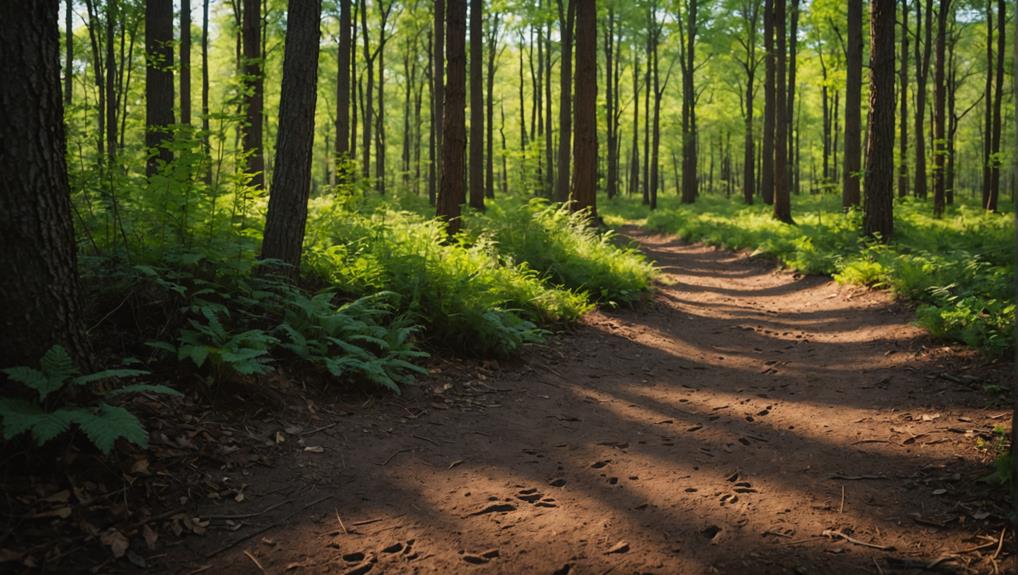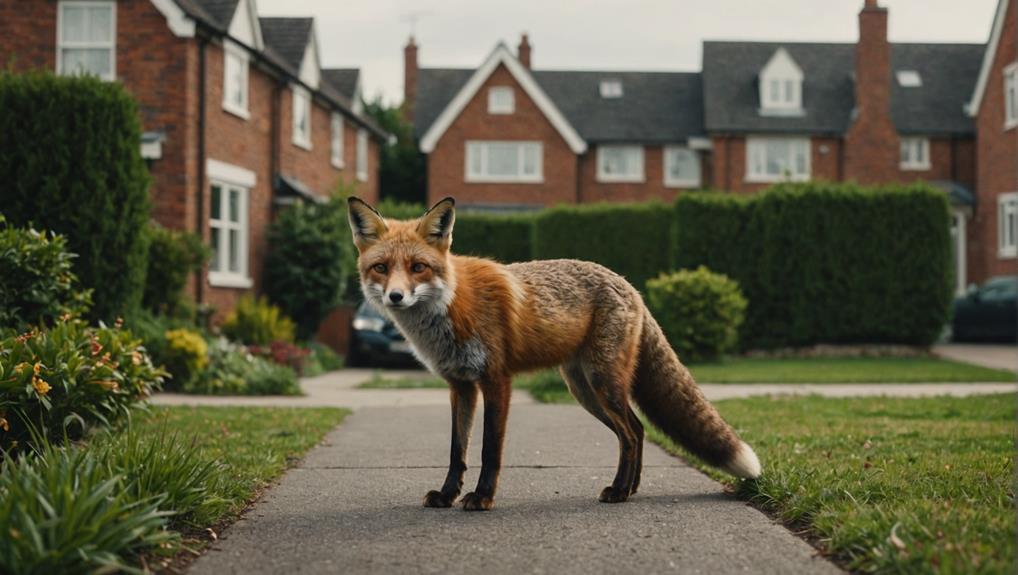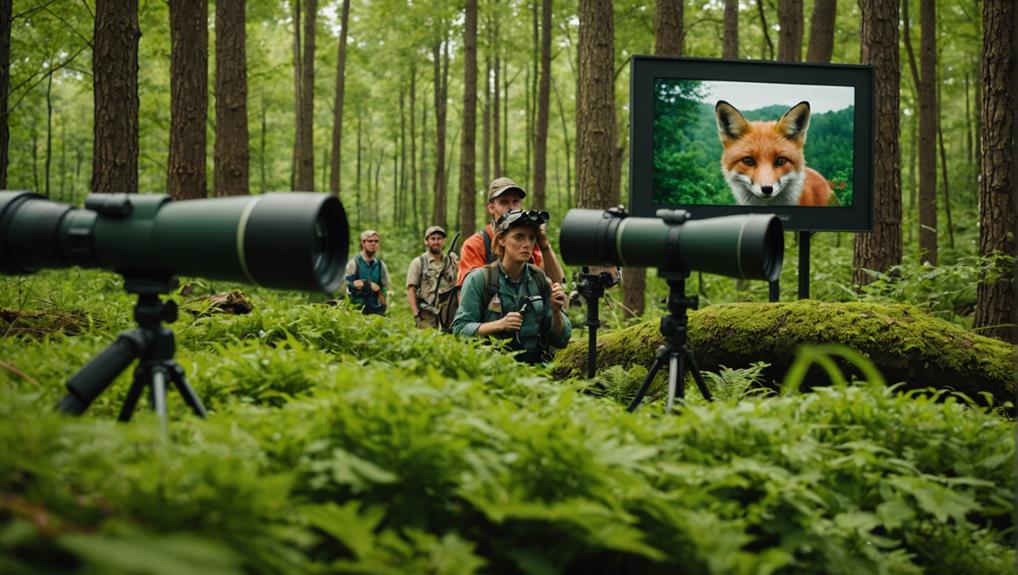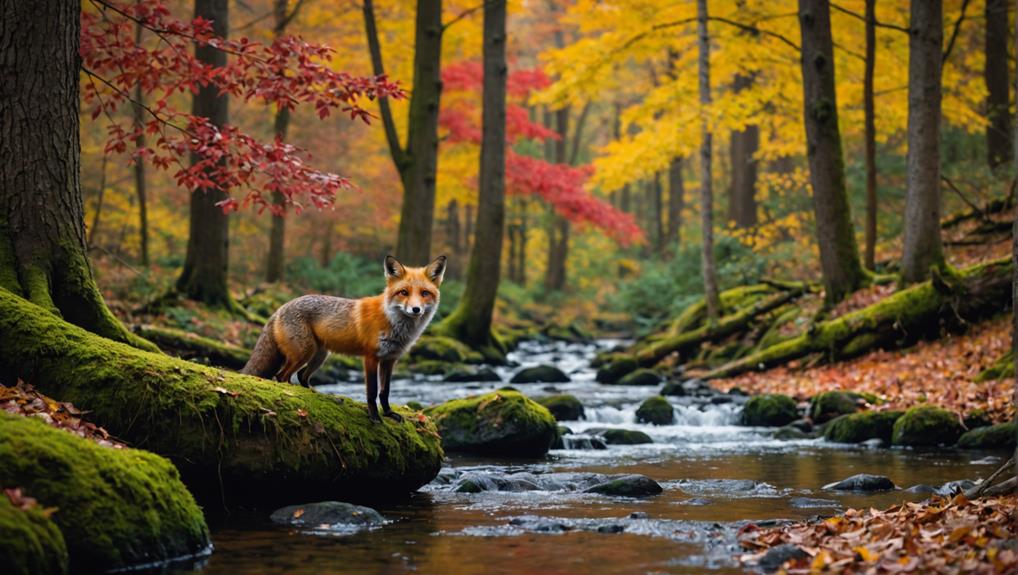Finding the right habitat for red foxes can be a fun adventure! Start by checking out mixed forests and open fields, as they love hunting there. Wetlands are their go-to for water and food. Don't forget about urban areas; red foxes are excellent scavengers, often seen raiding garbage bins! Look for densely vegetated spots for their dens, preferably in well-drained areas. Also, consider seasonal changes; they adapt by moving to sheltered spots in winter. Lastly, keep track of climate impacts; warmer weather can affect food availability. Stick around, and you'll discover more about these clever critters and their homes!
Contents
Understanding Red Fox Distribution
When you think about red foxes, consider their impressive adaptability as they thrive in a variety of habitats across the continental U.S. These clever creatures can be found in places ranging from woodlands to suburban neighborhoods. You might even spot them in urban areas, like parks and gardens, where they cleverly take advantage of human leftovers. It's almost as if they've mastered city living!
Their territories can stretch up to 50 square kilometers, but don't worry—they don't need that much space if resources are plentiful. The adaptability of red foxes allows them to establish populations in areas where food is readily available. Interestingly, the rarest populations are in the Southwest, showing how important habitats are for their survival.
As you learn about these fascinating animals, think about how they navigate their environment with such grace and cleverness. Red foxes serve as a reminder of nature's resilience.
Whether in rural fields or bustling cities, they make the most of what they have. So, next time you see one, give it a nod for its adaptability and resourcefulness! After all, they're not just surviving; they're thriving!
Identifying Red Fox Habitats
When you're out exploring nature, spotting a red fox can feel like a delightful surprise.
These clever critters love mixed forests, open fields, and even parks, adapting to both rural and suburban life with ease. As you learn to identify their habitats, you'll discover how seasonal changes affect where they hang out and even how they make use of our spaces—who knew they could find cozy spots right in our backyards?
Preferred Habitat Types
Throughout their range, red foxes thrive in diverse habitats that suit their hunting and foraging needs. These clever creatures are adaptable, making them a common sight in both rural and suburban neighborhoods. Let's dive into their preferred habitat types!
| Preferred Habitat Types | Description |
|---|---|
| Mixed Forests | Provides cover for hunting and shelter. |
| Open Fields | Ideal for chasing down small prey. |
| Wetlands | Offers abundant food and great hiding spots. |
| Transition Zones | Where forests meet fields, perfect for foraging. |
| Urban Environments | Red foxes have learned to navigate human spaces. |
Red foxes love open fields and wetlands, where they can hunt with ease. Their solitary nature means they often prefer areas that allow them to stay hidden from both prey and potential threats. And don't forget, they tend to hang around water sources, especially during rainy seasons when denning becomes a bit trickier.
Urban Adaptation Strategies
Urban red foxes frequently adapt to life in bustling cities, cleverly utilizing parks, gardens, and residential backyards as their habitats. Their adaptability is impressive!
These crafty creatures often establish den sites in areas with good drainage, like abandoned burrows or the cozy space under your deck. They know how to make themselves at home!
In the urban landscape, red foxes thrive by finding food sources that suit their needs. You might spot them scavenging carrion in alleys or rummaging through garbage bins, adapting their diet to include leftover human food along with their natural prey, such as rodents and insects.
Who knew a fox could be such a foodie?
Water is essential for their survival, so they prefer habitats near streams or ponds.
If you're trying to help them thrive, consider leaving some natural spaces in your garden. You never know, a red fox might appreciate your efforts!
Seasonal Habitat Changes
As seasons change, red foxes adapt their habitats to optimize survival and foraging. These clever creatures thrive in diverse environments like woodlands, wetlands, and even urban neighborhoods. Their adaptability helps them navigate seasonal shifts, ensuring they find food and shelter.
During winter, red foxes often retreat to dens for warmth and safety, especially when raising their young. They prefer spots with good drainage, keeping their homes cozy and dry. As temperatures drop, they grow thicker fur, allowing them to brave the cold while still darting through both rural and urban settings.
When it comes to finding prey, red foxes are true opportunists. In winter, they might struggle to locate their favorite snacks like rodents or rabbits, so they adjust their foraging strategies accordingly.
In suburban areas, you might even spot them rummaging through garbage or eyeing farm animals—talk about resourceful! This can lead to more encounters between humans and foxes, so it's essential to be aware of their seasonal habits.
The Role of Climate

When you think about red foxes, consider how much climate shapes their lives.
These clever animals adapt to everything from chilly Alaskan winters to sunny Florida days, changing their fur and behavior with the seasons.
Plus, their dinner menu shifts depending on what's available, so you might say they're the ultimate foodies of the wild!
Temperature and Shelter Needs
Red foxes demonstrate remarkable adaptability to diverse temperature ranges, making their shelter needs crucial for survival.
These clever creatures grow thicker fur in autumn and winter, which helps them stay warm during chilly weather. When it comes to habitats, they prefer areas with plenty of cover, like wooded spots, brushy fields, and wetlands. This not only offers protection from predators but also shields them from extreme temperatures.
As the climate shifts, red foxes become more reliant on their dens, especially during winter months. Dens provide a warm, cozy place for them to snuggle up, and they also keep their young safe from the cold.
Interestingly, these foxes are smart about where they choose to dig their dens, often looking for spots that won't flood during heavy rains.
You might be surprised to learn that urban environments can actually help red foxes beat the heat and cold alike. They often find shelter in human structures and scavenge food, reducing their need for natural habitats.
Seasonal Behavior Changes
Seasonal changes significantly influence how red foxes behave and utilize their habitats. During the chilly winter months, foxes increase their den use, seeking cozy spots to escape the cold and raise their young. Isn't it fascinating that they grow thicker fur to brave the lower temperatures? This adaptation allows them to thrive in a variety of climates!
As the seasons shift, food availability plays a big role in their foraging habits. In the summer, you might find them munching on insects and fruits, while winter calls for a diet rich in small mammals.
When it's mating season, they seek out those dense cover areas and suitable denning sites, prioritizing habitats that offer protection against harsh weather conditions.
What's more, red foxes are clever creatures! They've learned to exploit urban environments, ensuring a steady food source year-round despite the natural prey's availability changing with the seasons.
Climate Impact on Food
Climate change significantly impacts the food sources available to red foxes. As temperatures shift and weather patterns change, the availability of small mammals and fruits that these clever creatures rely on can fluctuate dramatically.
You might wonder how this all connects, so let's break it down:
- Warmer winters can boost rodent populations, offering red foxes more food during critical foraging times.
- Extreme weather events, like heavy snowfalls, can make hunting tough, pushing foxes to scavenge or rummage through garbage for scraps.
- Shifts in vegetation can change the landscape, affecting where red foxes find dens and their usual foraging spots.
These climate changes force red foxes to adapt their foraging behaviors and possibly their dietary habits, seeking out new sources of food.
It's like a game of survival, where every adjustment counts! As we learn about their struggles, we can better appreciate the delicate balance of nature and consider how our actions can support their habitats.
Red Fox Adaptation Strategies
Thriving in diverse environments, red foxes showcase impressive adaptation strategies that allow them to flourish in both urban and rural settings. You might be surprised to learn that these clever creatures can make their homes in parks, brushy fields, and even your neighborhood!
Their solitary nature helps them stay under the radar, allowing them to slip away from human encounters and navigate through densely populated areas.
One of the key secrets to their success is adaptability. Red foxes can quickly adjust their habits based on the changing seasons. They choose dens based on drainage, especially when heavy rainfall comes knocking.
Plus, when it comes to foraging, they're true opportunists! Scavenging from garbage cans or farms provides them with food that's just too tempting to resist.
Impact of Urbanization

Urbanization has significantly reshaped the habitats of red foxes, allowing them to adapt to city life with remarkable ease. You might be surprised to learn how resourceful these clever creatures can be!
They've made urban environments their new playgrounds, using parks, gardens, and even suburban backyards for nesting and foraging. Here are a few ways they thrive:
- They enjoy a consistent food source by scavenging from garbage cans.
- They might sneak a snack from your small pets or even poultry if given the chance.
- Their territories have expanded, letting them roam freely through bustling neighborhoods.
As red foxes adapt to their urban surroundings, they often change their behavior. For instance, they become more nocturnal to avoid human interactions.
While this can lead to increased encounters, it's essential to remember that these sly foxes are just trying to make a living in a new world.
Conservation Efforts
As red foxes navigate the challenges of their changing habitats, conservation efforts play a crucial role in ensuring their survival. You can be part of these efforts by supporting initiatives focused on habitat restoration, especially in urban areas where foxes have learned to coexist with us. By preserving wooded tracts, wetlands, and brushy fields, we can provide essential spaces for red fox denning and foraging.
Public awareness campaigns are another vital piece of the puzzle. They help reduce human-wildlife conflicts by encouraging communities to respect and protect fox habitats. When people understand the ecological role of foxes, they're more likely to support conservation efforts that benefit both the animals and the ecosystems we share.
Monitoring fox populations is also key. Local and state organizations gather important data to help manage and conserve these clever creatures.
You can get involved by donating, signing petitions, or joining events that promote red fox conservation. Every effort counts! So, let's work together to ensure that future generations can enjoy the charm of red foxes in their natural habitats. After all, who doesn't love a good fox tale?
Engaging With Wildlife Organizations

Connecting with wildlife organizations can amplify your impact on red fox conservation efforts. These groups are passionate about protecting our furry friends and can be a fantastic resource for you.
By engaging with them, you'll not only learn more but also join a community dedicated to making a difference. Here are three ways you can get involved:
- Report Sightings: When you spot a red fox, let the organization know! Your observations can help track their behaviors and populations.
- Join Citizen Science Initiatives: Participate in programs where you can collect data and contribute to real research, making you part of the solution.
- Attend Events: Get hands-on experience at local wildlife events. You'll gain insights into habitat restoration and conservation efforts, plus meet like-minded people.
Don't forget to sign up for newsletters. They'll keep you updated on educational materials and upcoming events where you can lend a hand.
Your involvement not only supports habitat restoration but also nurtures a thriving community of wildlife advocates. So dive in, have fun, and make a positive impact on the red fox population!
Final Thoughts
So, now that you've learned about red fox habitats and their clever ways of adapting, you can see just how fascinating these creatures are. Whether they're dodging cars in the city or thriving in the wild, they've got some serious survival skills! By supporting conservation efforts, you can help ensure these charming foxes continue to thrive. So, let's keep our eyes peeled for those bushy tails and remember to appreciate the wild wonders around us!














